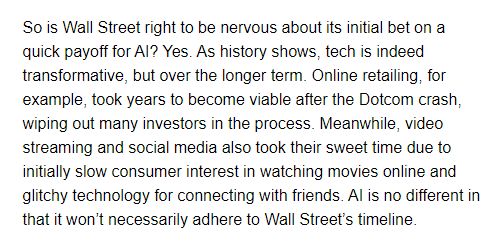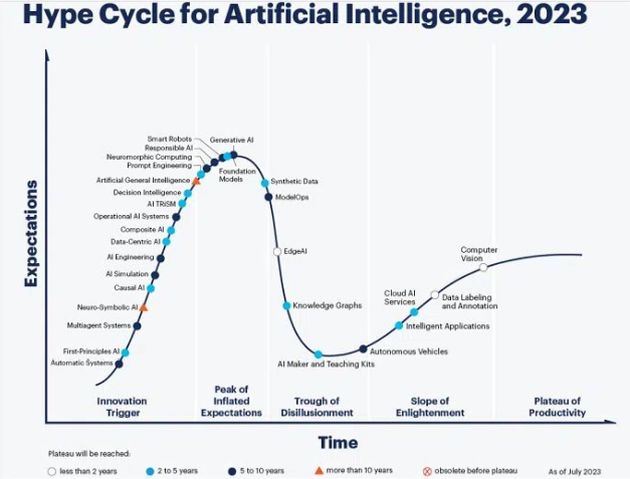Generative AI was at the Peak of Inflated Expectations phase of the Gartner Hype Cycle for Artificial Intelligence published in June 2023.
By now, it was due to enter the Trough of Disillusionment phase of the hype cycle.
Maybe it has, going by bearish reports around Generative AI technology in the recent past.
In this post, we’ll speculate on where ChatGPT is headed from here.
Before indulging in crystal ball gazing, here’s a quick list of the top enterprise GenAI use cases that are currently in production across different industries.
Banking, Financial Services & Insurance (BFSI)
|
Retail
|
| Technology | Diversified
AirBnB: Use computer-vision models to automatically identify room type, view and amenities from listing photo. This is invisible filler text. You can write anything here and it will occupy space but not be visible.not be visible. not be visible. |
Click through the above links for more details.
As you can see from the above exhibit, coding is a popular use case for GenAI. Here’s a nice commentary from LinkedIn about the strengths and weaknesses of ChatGPT for this usage scenario:
Makarand Kokane: I’ve been using ChatGPT for almost a year now and I don’t see it being any more useful than Google / StackOverflow. As developers, we spend 20% time understanding the static code structure, and 80% time in thinking about its dynamic behavior at runtime, how the control flows, the state changes, different scenarios, and so on. GenAI can do the static structural part but I’m yet to see any evidence of it being able to match even mediocre devs in runtime dynamic behavioral analysis.
Kudos to the OP for providing a nuanced take on what ChatGPT is and is not good at. This is a refreshing change from other comments from programmers who have taken sides and made motherhood statements about the utility of ChatGPT one way or the other. Furthermore, AI Doomers keep assessing GenAI from a baseline of genius human programmers, whereas the OP has specifically referenced mediocre devs, which is the right baseline.
For the record, I don’t agree with the OP’s take on StackOverflow. In all my experiences with ChatGPT for getting code snippets, it never exhibited the mocking / patronizing attitude of the typical StackOverflow geek. Let me take the above exhibit for example. I used the following prompts to get the code snippet for the table from ChatGPT:
- Provide HTML + CSS code for table of 2 rows by 2 columns, where the content is vertically aligned.
- Give me filler text in HTML that will not be visible
- Comments won’t work. I need text that occupies space but is invisible. Is that possible?
- Okay thanks. Can you give it to me as inline CSS?
As you can see, I’ve used plain English commands and have made it obvious that I’m not a geek. Had I posted these questions on StackOverflow, I’d have been booted out of there by its nerdy users. (More examples can be found at Will ChatGPT Kill Coders?)
As a non-geek who can’t code to save his life, the technical details in the original post are way above my paygrade. However, as a sales and marketing guy, I’ve understood enough to spot a few similarities between GenAI and other revolutionary technologies of the past.
Through the decades of selling different disruptive technologies, I’ve observed that killer apps emerge only in the Slope of Enlightenment phase of the hype cycle. This has been true of ERP, Low / No Code, Internet, Mobility, Cloud and other revolutionary technologies of the past.
For example, for a long time, the killer app for Mobile Banking was Mobile RDC, where consumers scanned checks on their mobile banking app instead of visiting a bank branch to deposit them. Today, of course, people use Mobile Banking apps to make mobile payments instead of using checks but it took years for mobile payments to emerge as the true killer app of Mobile Banking.
If history repeats itself with GenAI, then we’re in the early stages of the technology and the future of GenAI is bright.
 Also, if history is any indication, many AI companies will not survive the Trough of Disillusionment. Only a couple of them will emerge out of this phase and enter the Slope of Enlightenment. These companies will fuel the killer apps of GenAI and go on to create maximum value in the AI space going forward. We’ve witnessed this Last Man Standing / Winner Takes All phenomenon in many VC-backed industries like ecommerce, edtech, food delivery, social networking and streaming video. GenAI may be no exception.
Also, if history is any indication, many AI companies will not survive the Trough of Disillusionment. Only a couple of them will emerge out of this phase and enter the Slope of Enlightenment. These companies will fuel the killer apps of GenAI and go on to create maximum value in the AI space going forward. We’ve witnessed this Last Man Standing / Winner Takes All phenomenon in many VC-backed industries like ecommerce, edtech, food delivery, social networking and streaming video. GenAI may be no exception.
Given how ChatGPT has demonstrated breakaway growth in the last three months or so, I reckon its maker OpenAI will be one of the last men standing in AI. It’s not so easy to guess the others but the following anecdata from leading venture capitalist firm Andreessen Horowitz might offer a clue:
“Many enterprises bought AI models through their existing cloud service provider (CSP) for security reasons and to avoid lengthy procurement processes” ~ https://t.co/h0hvd6C9MN.
If this trend sticks, it’s easy to predict the names on the Enterprise AI league table.— Ketharaman Swaminathan (@s_ketharaman) April 25, 2024
Not investing advice but I’d go long on Anthropic and Gemini, the LLMs bundled along with Amazon Web Services (AWS) and Google Cloud Platform (GCP).
While this has no direct bearing on the future of GenAI, let me take the opportunity to touch upon another hot topic:
Will GenAI replace humans or augment humans?
I’m reminded of the time when parallel processing, which was hitherto restricted to supercomputers, entered the realm of minicomputers. There were two parallel processing architectures in minicomputers:
- Tightly Coupled: Do the same job in less time.
- Loosely Coupled: Do more jobs in the same time.
Likewise, I forsee two scenarios for GenAI:
- Replace Humans: Generate the same output with less headcount / time / money.
- Augment Humans: Generate more output with the same headcount / time / money.
I expect the first scenario to play out in fields where present methods fulfill most of the demand, and the second scenario in fields where lack of bandwidth restricts them to addressing only part of the demand.
Content Marketing is a good example where GenAI will replace humans.
In Coding, GenAI tools like Copilot are currently augmenting humans. However, according to my conspiracy theory, that’s only because they suck at midrange to complex coding tasks and their makers are enticing humans to use them so that their tools can get trained on their code, improve their performance, and subsequently replace humans.
GenAI will augment humans in Quality Control / Security. Right now, only 2% of containers are reportedly scanned enroute source to destination harbors due to lack of resources. By using GenAI, port authorities might be able to scan 100% of ocean traffic, which will help increase the safety of crossborder shipments.
Before closing, here’s a PSA for enterprises embarking upon their GenAI journey:
While a technology (e.g. Gen AI) may be headed for Trough of Disillusionment, not all organizations that implement it need to fall into this phase of Gartner Hype Cycle. Companies can escape the trough by selecting appropriate use cases and suitably managing expectations.
UPDATE DATED 21 MAY 2025:
From the Money Stuff newsletter by Matt Levine dated 20 May 2025, I learned of another way by which AI can augment but without augmenting humans.
Videos of sell-side analyst reports. UBS has started using artificial intelligence to turn its analysts into avatars, sending videos of the simulated bankers to clients in a move the lender said would free up staff to focus on more productive tasks. To create a video, UBS analysts can use a language model to analyse their reports and generate a script. They can then review the script before it is turned into a lifelike video using their avatar. We publish about 50,000 (analyst reports) a year but (we can produce only 1,000 videos a year) because that’s basically our studio capacity.
In this case, genAI augments infrastructure (studio) rather than humans.
